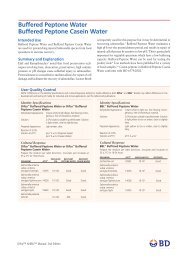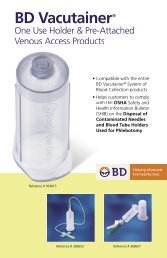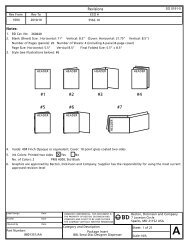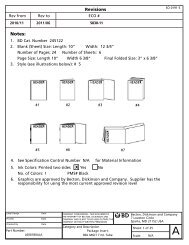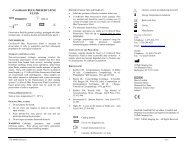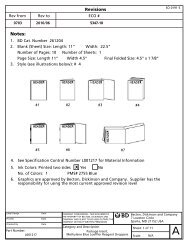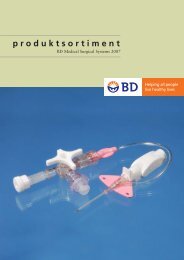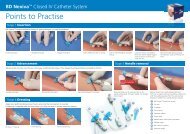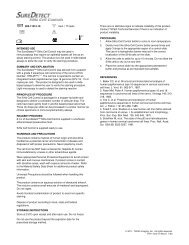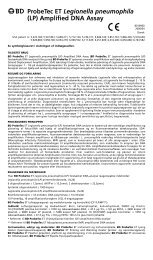Notes: - BD
Notes: - BD
Notes: - BD
Create successful ePaper yourself
Turn your PDF publications into a flip-book with our unique Google optimized e-Paper software.
BACTEC Mycosis-IC/F Culture Vials<br />
Selective Medium for Yeast and Fungi<br />
English: pages 1 – 3 Español: páginas 10 – 12<br />
Français : pages 3 – 5 Dansk: side 12 – 14<br />
Deutsch: Seiten 5 – 7 Português: páginas 14 – 16<br />
Italiano: pagine 8 – 10 Svenska: sidan 16 – 18<br />
<br />
PP113JAA<br />
2010/02<br />
INTENDED USE<br />
BACTEC Mycosis-IC/F culture vials are for aerobic blood cultures. Principal use is with the BACTEC fluorescent series instruments for the selective<br />
culture and recovery of yeasts and fungi from blood.<br />
SUMMARY AND EXPLANATION<br />
The sample to be tested is inoculated into one or more vials which are inserted into the BACTEC fluorescent series instrument for incubation and<br />
periodic reading. Each vial contains a chemical sensor which can detect increases in CO2 produced by the growth of microorganisms. The sensor is<br />
monitored by the instrument every ten minutes for an increase in its fluorescence, which is proportional to the amount of CO2 present. A positive<br />
reading indicates the presumptive presence of viable microorganisms in the vial.<br />
PRINCIPLES OF THE PROCEDURE<br />
If yeast and fungi are present in the test sample inoculated into the BACTEC vial, CO2 will be produced when the microorganisms metabolize the<br />
substrates present in the vial. Increases in the fluorescence of the vial sensor caused by the increase of CO2 are monitored by the BACTEC fluorescent<br />
series instrument. Analysis of the rate and amount of CO2 increase enables the BACTEC fluorescent series instrument to determine if the vial is positive,<br />
i.e., that the test sample contains viable organisms.<br />
REAGENTS<br />
The BACTEC Mycosis-IC/F culture vials contain the following reactive ingredients prior to processing:<br />
List of Ingredients<br />
Processed Water .................................................. 40 mL<br />
Brain Heart Infusion Broth .................................. 1.0% w/v<br />
Soybean-Casein Digest Broth .............................. 0.5% w/v<br />
Yeast Extract .......................................................... 0.035% w/v<br />
Sucrose .................................................................. 0.6% w/v<br />
Dextrose ................................................................ 0.1% w/v<br />
m-Inositol .............................................................. 0.05% w/v<br />
Ferric Ammonium Citrate .................................... 0.0001% w/v<br />
Sodium Polyanetholesulfonate (SPS) .................. 0.05% w/v<br />
Saponin .................................................................. 0.24% w/v<br />
Chloramphenicol .................................................. 0.0037% w/v<br />
Tobramycin ............................................................ 0.001% w/v<br />
Antifoaming Agent .............................................. 0.01% w/v<br />
All BACTEC media are dispensed with added CO2. Composition may have been adjusted to meet specific performance requirements.<br />
Warnings and Precautions<br />
For in vitro Diagnostic Use.<br />
This Product Contains Dry Natural Rubber.<br />
Pathogenic microorganisms, including hepatitis viruses and Human Immunodeficiency Virus, may be present in clinical specimens. "Standard<br />
Precautions" 1-4 and institutional guidelines should be followed in handling all items contaminated with blood and other body fluids.<br />
Prior to use, each vial should be examined for evidence of damage, contamination or deterioration. Vials displaying evidence of damage or<br />
contamination such as leakage, cloudiness, discoloration (darkening), bulging or depressed septum should not be used.<br />
A contaminated vial could contain positive pressure. If a contaminated vial is used for direct draw, contaminated culture media could be refluxed into<br />
the patient’s vein. Vial contamination may not be readily apparent. When using direct draw procedures, monitor the process closely to avoid refluxing<br />
materials into patient.<br />
On rare occasions, the glass bottle neck may be cracked and the neck may break during removal of the flip-off cap or in handling. Also, on rare<br />
occasions, a vial may not be sealed sufficiently. In both cases the contents of the vial may leak or spill. If the vial has been inoculated, treat the leak or<br />
spill with caution, as pathogenic organisms/agents may be present. Before discarding, sterilize all inoculated vials by autoclaving.<br />
Positive culture vials for subculturing or staining, etc.: Before sampling it is necessary to release gas which often builds up due to microbial metabolism.<br />
Sampling should be performed in a biological safety cabinet if possible, and appropriate protective clothing, including gloves and masks, should be<br />
worn. See Procedure section for more information on subculturing.<br />
To minimize the potential of leakage during inoculation of specimen into culture vials, use syringes with permanently attached needles or Luer-Lok<br />
brand tips.<br />
Storage Instructions<br />
The BACTEC vials are ready for use as received and require no reconstitution or dilution. Store in a dry place at 2–25°C, out of direct light.




